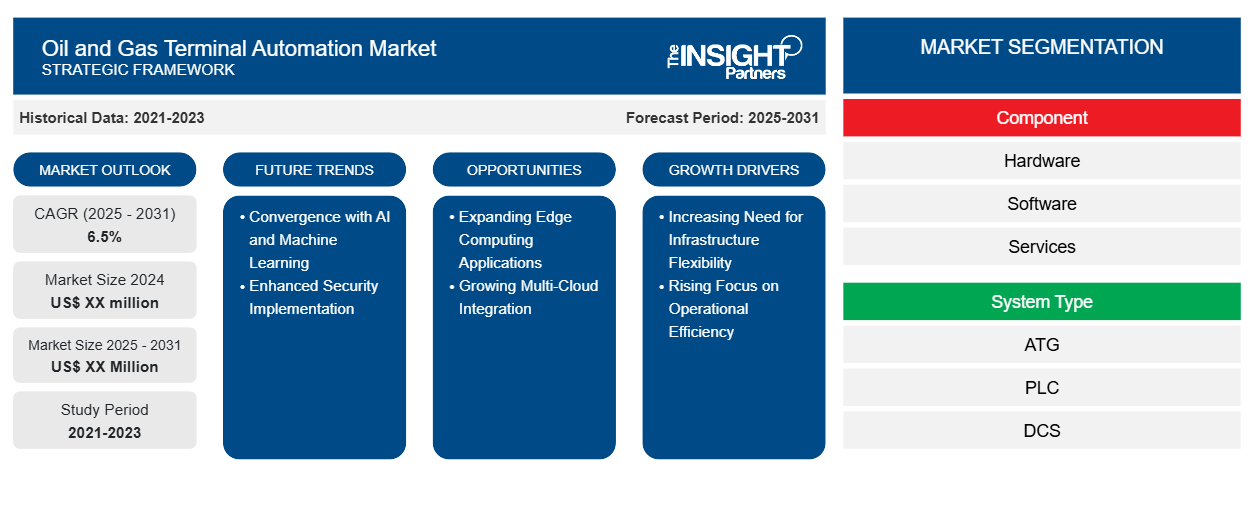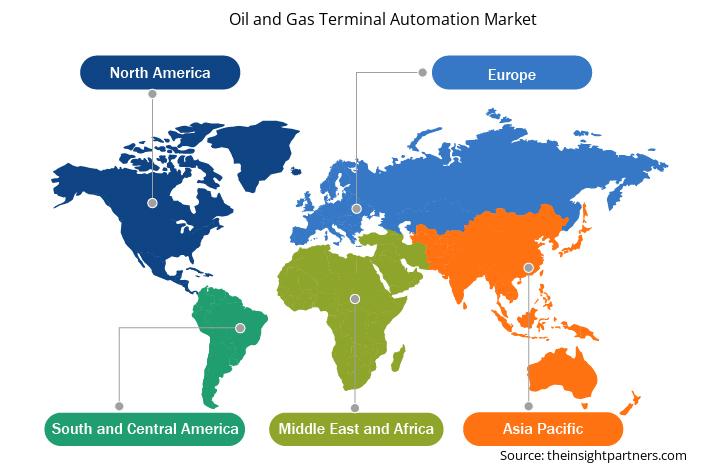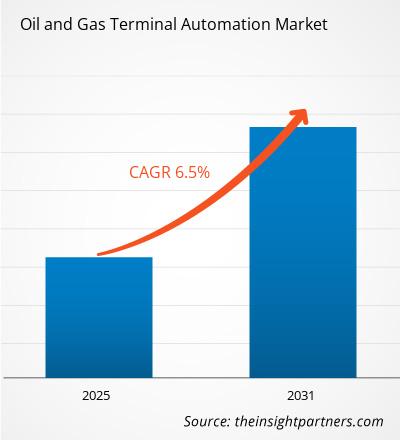预计石油和天然气终端自动化市场在 2025 年至 2031 年期间的复合年增长率为 6.5%,市场规模将从 2024 年的 XX 百万美元扩大到 2031 年的 XX 百万美元。
该报告按组件(硬件、软件、服务)、系统类型(ATG、PLC、DCS、HMI、SCADA、混合控制器、其他)、运营(终端和库存管理、业务系统集成、报告、交易管理、其他)进行细分。全球分析进一步细分为区域和主要国家。报告提供上述分析和细分的美元价值。
报告目的
Insight Partners 发布的《石油和天然气终端自动化市场》报告旨在描述当前的市场格局和未来增长、主要驱动因素、挑战和机遇。该报告将为各业务利益相关者提供洞见,例如:
- 技术提供商/制造商:了解不断变化的市场动态并了解潜在的增长机会,从而能够做出明智的战略决策。
- 投资者:对市场增长率、市场财务预测以及整个价值链中存在的机会进行全面的趋势分析。
- 监管机构:监管市场政策和警察活动,旨在最大限度地减少滥用行为,维护投资者的信任和信心,维护市场的完整性和稳定性。
石油和天然气终端自动化市场细分
成分
- 硬件
- 软件
- 服务
系统类型
- 抗逆转录病毒治疗
- PLC
- 分布式控制系统
- 人机界面
- 数据采集与数据采集系统
- 混合控制器
手术
- 终端和库存管理
- 业务系统集成
- 报告
- 交易管理
地理
- 北美
- 欧洲
- 亚太地区
- 中东和非洲
- 南美洲和中美洲
定制此报告以满足您的要求
您可以免费定制任何报告,包括本报告的部分内容、国家级分析、Excel 数据包,以及为初创企业和大学提供优惠和折扣
石油和天然气终端自动化市场:战略洞察

- 获取此报告的顶级关键市场趋势。此免费样品将包括数据分析,从市场趋势到估计和预测。
石油和天然气终端自动化市场的增长动力
- 对基础设施灵活性的需求日益增长:对适应性强、可扩展的 IT 基础设施日益增长的需求,正在推动各行各业采用 SDx。传统的以硬件为中心的架构已被证明过于僵化,无法满足快速发展的业务需求。软件定义解决方案使企业能够通过编程控制动态调整其基础设施,从而减少对物理硬件变更的依赖。这种灵活性能够快速响应不断变化的工作负载需求,加快新服务的部署速度,并提高资源利用效率。对于正在进行数字化转型的企业而言,通过软件命令重新配置网络、存储和计算资源的能力至关重要,尤其是在敏捷性和可扩展性至关重要的云环境中。
- 日益重视运营效率:企业日益重视降低运营成本并提升服务交付,这推动了 SDx 市场的增长。手动配置和管理基础设施组件既耗时又容易出错。软件定义方法可以自动化日常任务,简化操作,并减少基础设施管理中的人为干预。这种自动化显著降低了运营成本,同时提高了一致性和可靠性。SDx 解决方案的集中控制和管理功能使企业能够实施标准化策略,确保合规性,并优化整个基础设施的资源分配,从而显著提高效率并节省成本。
油气终端自动化市场未来趋势
- 与人工智能和机器学习的融合:将人工智能和机器学习功能集成到软件定义基础设施 (SDx) 解决方案中正成为一种重要趋势。这些技术能够实现预测性基础设施优化、自动化问题解决和智能资源分配。基于人工智能的软件定义基础设施 (SDx) 系统可以分析资源使用模式,预测潜在问题,并自动调整配置以优化性能。这种趋势在大规模部署中尤为明显,因为手动监控和优化已变得不切实际。人工智能与软件定义基础设施的结合正在创建能够适应不断变化的环境而无需人工干预的自优化系统。
- 增强安全实施:随着企业将网络防御置于优先地位,SDx 架构内安全功能的演进正成为一种决定性趋势。软件定义安全支持在整个基础架构中实施动态策略、微分段和自动威胁响应。这一趋势反映出企业需要能够快速适应威胁演变的安全措施。企业正在实施全面的安全框架,利用 SDx 的可编程性来创建零信任环境、执行合规性要求,并通过自动检测和响应机制抵御复杂的网络威胁。
石油和天然气终端自动化市场机遇
- 扩展边缘计算应用:边缘计算的快速发展为软件定义基础设施 (SDx) 的实施带来了巨大的机遇。随着企业在网络边缘部署越来越多的计算资源,软件定义基础设施对于有效管理分布式环境至关重要。SDx 能够在保持集中控制的同时,跨边缘位置实现一致的策略实施、资源优化和安全性。这一机遇涵盖从物联网设备管理到内容交付网络等各种应用,在这些应用中,以编程方式控制边缘基础设施的能力可在性能和效率方面带来显著优势。
- 日益增长的多云集成:多云战略的日益普及为 SDx 解决方案创造了巨大的机遇。企业需要工具来无缝管理和协调跨多个云提供商和本地基础设施的资源。软件定义方法能够跨不同的云环境实现一致的管理、安全策略和服务交付。这一机遇包括开发用于云无关资源管理、自动化工作负载迁移和统一策略实施的工具。管理混合云和多云环境的复杂性推动了对能够抽象和简化这些操作的复杂 SDx 解决方案的需求。
石油和天然气终端自动化市场区域洞察
Insight Partners 的分析师已详尽阐述了预测期内影响油气终端自动化市场的区域趋势和因素。本节还讨论了北美、欧洲、亚太地区、中东和非洲以及南美和中美洲的油气终端自动化市场细分和地域分布。

- 获取石油和天然气终端自动化市场的区域具体数据
石油和天然气终端自动化市场报告范围
| 报告属性 | 细节 |
|---|---|
| 2024 年的市场规模 | XX百万美元 |
| 2031 年市场规模 | XX 百万美元 |
| 全球复合年增长率(2025 - 2031) | 6.5% |
| 史料 | 2021-2023 |
| 预测期 | 2025-2031 |
| 涵盖的领域 | 按组件
|
| 覆盖地区和国家 | 北美
|
| 市场领导者和主要公司简介 |
|
油气终端自动化市场参与者密度:了解其对业务动态的影响
油气终端自动化市场正在快速增长,这得益于终端用户需求的不断增长,而这些需求的驱动因素包括消费者偏好的不断变化、技术进步以及对产品优势的认知度不断提高。随着需求的增长,企业正在扩展产品线,不断创新以满足消费者需求,并抓住新兴趋势,从而进一步推动市场增长。
市场参与者密度是指特定市场或行业内企业或公司的分布情况。它表明特定市场空间内竞争对手(市场参与者)的数量相对于其规模或总市值而言。
在石油和天然气终端自动化市场运营的主要公司有:
- ABB
- 埃默森电气公司
- Endress+Hauser管理股份公司
- FMC技术公司
- 霍尼韦尔国际公司
免责声明:以上列出的公司没有按照任何特定顺序排列。

- 获取石油和天然气终端自动化市场顶级关键参与者概述
主要卖点
- 全面覆盖:报告全面涵盖了石油和天然气终端自动化市场的产品、服务、类型和最终用户的分析,提供了整体概况。
- 专家分析:本报告基于对行业专家和分析师的深入了解而编写。
- 最新信息:该报告涵盖了最新信息和数据趋势,确保了业务相关性。
- 定制选项:此报告可以定制以满足特定客户要求并适合业务策略。
因此,这份关于油气终端自动化市场的研究报告有助于引领我们解读和理解行业现状及增长前景。尽管存在一些合理的担忧,但本报告的总体优势往往大于劣势。
- 历史分析(2 年)、基准年、预测(7 年)及复合年增长率
- PEST和SWOT分析
- 市场规模、价值/数量 - 全球、区域、国家
- 行业和竞争格局
- Excel 数据集
近期报告
相关报告
客户评价
购买理由
- 明智的决策
- 了解市场动态
- 竞争分析
- 客户洞察
- 市场预测
- 风险规避
- 战略规划
- 投资论证
- 识别新兴市场
- 优化营销策略
- 提升运营效率
- 顺应监管趋势




















 获取免费样品 - 石油和天然气终端自动化市场
获取免费样品 - 石油和天然气终端自动化市场